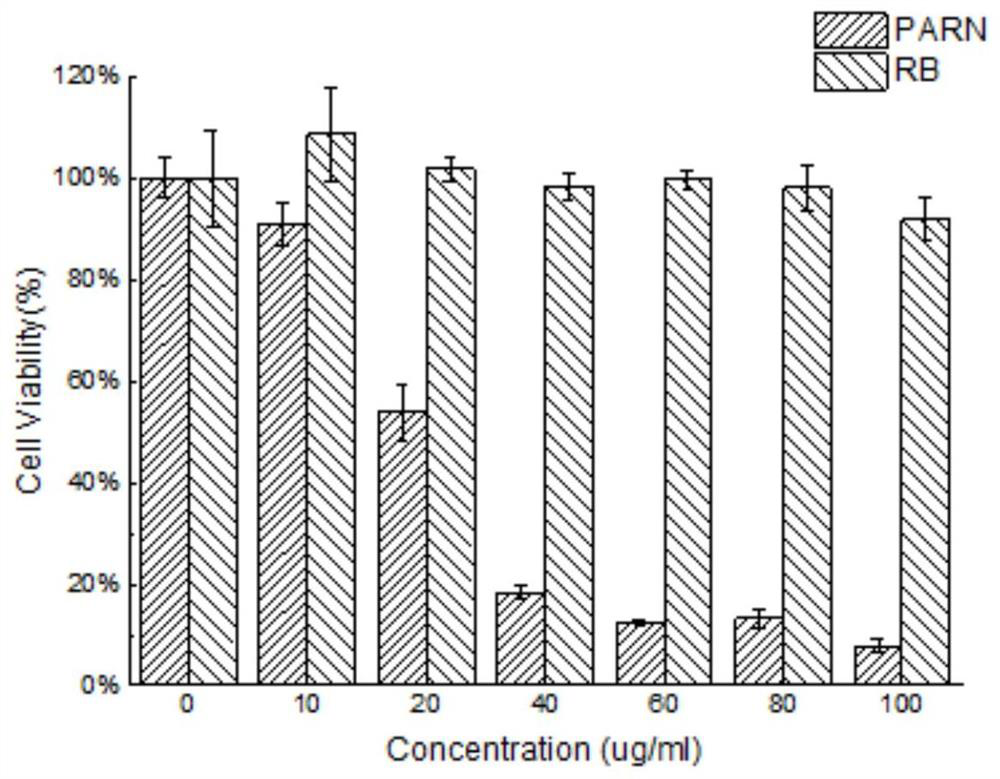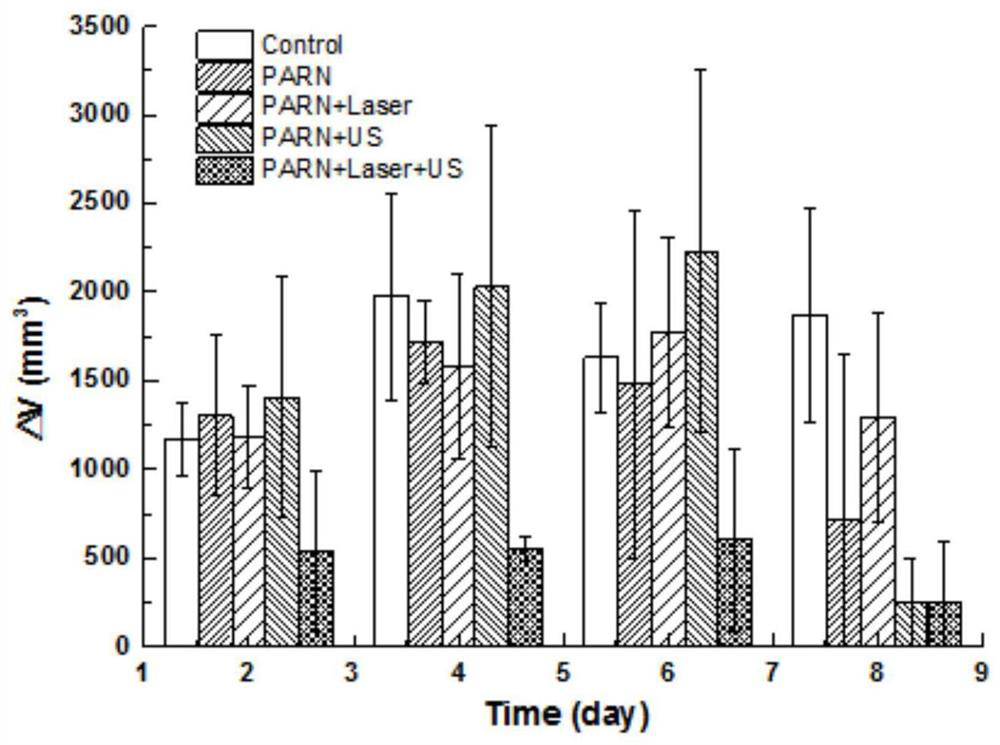Composite nanomicelle for multimodal treatment of nasopharyngeal carcinoma and its preparation method and application
A nano-micelle and nasopharyngeal cancer technology, applied in photodynamic therapy, medical preparations containing active ingredients, pharmaceutical formulas, etc., can solve the problems of difficult enrichment of target tissues and limited applications, and achieve good biodegradability properties, ease of chemical modification, and good biocompatibility
- Summary
- Abstract
- Description
- Claims
- Application Information
AI Technical Summary
Problems solved by technology
Method used
Image
Examples
Embodiment 1
[0025] Example 1: Preparation of composite nanomicelles for multimodal treatment of nasopharyngeal carcinoma:
[0026] 1) Mix the amphiphilic peptide ultrapure aqueous solution with the Bengal Rose Bengal ultrapure aqueous solution and place it in an ultrasonic cleaner; under the conditions of a temperature of 20 degrees Celsius and a power of 28 kHz, fully mix for 20-40 minutes to obtain a composite amphiphilic peptide nanomicelle product; wherein, the concentration of the amphiphilic peptide ultrapure aqueous solution is 10 mg / ml; the concentration of the described rose bengal ultrapure aqueous solution is a solution of 2 mg / ml. The volume ratio of the amphiphilic peptide ultrapure aqueous solution to the Rose Bengal ultrapure aqueous solution is 2:1.
[0027] 2) Transfer the above composite amphiphilic peptide nanomicelles obtained in step 1) to a dialysis bag with a molecular weight cut-off of 1000 Daltons, and dialyze for 48 to 72 hours to obtain the composite amphiphilic...
Embodiment 2
[0028] Example 2: Preparation of composite nanomicelles for multimodal treatment of nasopharyngeal carcinoma:
[0029] 1) Mix the amphiphilic peptide ultrapure aqueous solution with Bengal Rose Bengal ultrapure aqueous solution and place it in an ultrasonic cleaner; at a temperature of 5 degrees Celsius and a power of 15 kHz, mix thoroughly for 20-40 minutes to obtain a composite amphiphilic peptide nanomicelle Product; wherein, the concentration of the amphiphilic peptide ultrapure aqueous solution is 5 mg / ml; the concentration of the described rose bengal ultrapure aqueous solution is a solution of 0.5 mg / ml. The volume ratio of the amphiphilic peptide ultrapure aqueous solution to the rose bengal ultrapure aqueous solution is 1:1.
[0030] 2) Transfer the above composite amphiphilic peptide nanomicelles obtained in step 1) to a dialysis bag with a molecular weight cut-off of 800 Daltons, and dialyze for 48 to 72 hours to obtain a composite amphiphilic peptide nanomicelle ta...
Embodiment 3
[0031] Example 3: Preparation of composite nanomicelles for multimodal treatment of nasopharyngeal carcinoma:
[0032] 1) Mix the amphiphilic peptide ultrapure aqueous solution with the Bengal Rose Bengal ultrapure aqueous solution and place it in an ultrasonic cleaner; at a temperature of 28 degrees Celsius and a power of 30 kHz, mix thoroughly for 20-40 minutes to obtain a composite amphiphilic peptide nanomicelle Product; wherein, the concentration of the amphiphilic peptide ultrapure aqueous solution is 15 mg / ml; the concentration of the described rose bengal ultrapure aqueous solution is a solution of 2.5 mg / ml. The volume ratio of the amphiphilic peptide ultrapure aqueous solution to the Rose Bengal ultrapure aqueous solution is 2:1.
[0033] 2) Transfer the above composite amphiphilic peptide nanomicelles obtained in step 1) to a dialysis bag with a molecular weight cut-off of 1500 Daltons, and dialyze for 48 to 72 hours to obtain a composite amphiphilic peptide nanomic...
PUM
 Login to View More
Login to View More Abstract
Description
Claims
Application Information
 Login to View More
Login to View More - R&D Engineer
- R&D Manager
- IP Professional
- Industry Leading Data Capabilities
- Powerful AI technology
- Patent DNA Extraction
Browse by: Latest US Patents, China's latest patents, Technical Efficacy Thesaurus, Application Domain, Technology Topic, Popular Technical Reports.
© 2024 PatSnap. All rights reserved.Legal|Privacy policy|Modern Slavery Act Transparency Statement|Sitemap|About US| Contact US: help@patsnap.com










